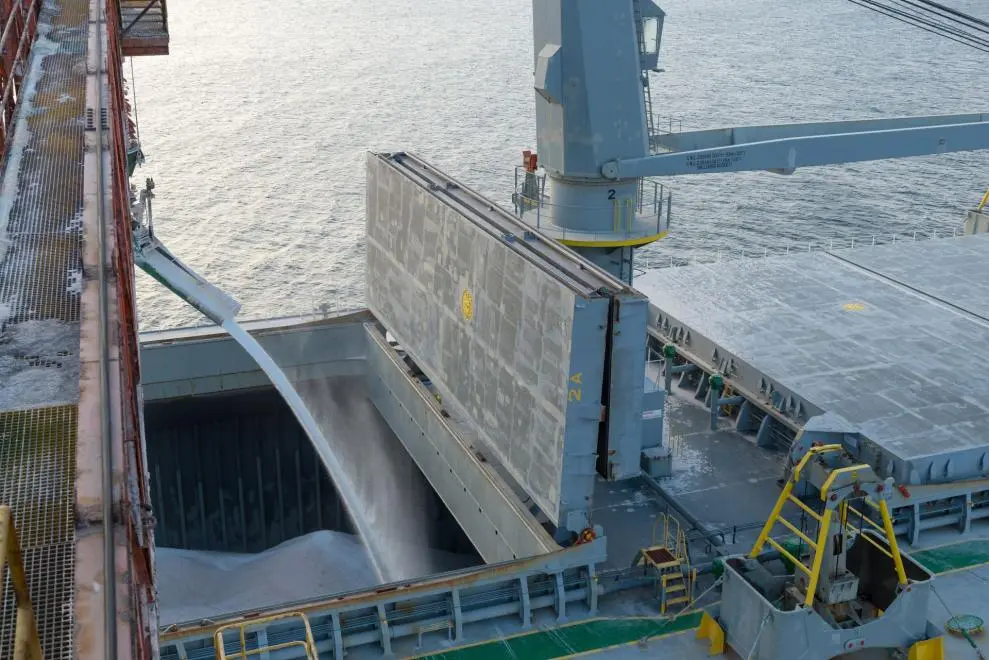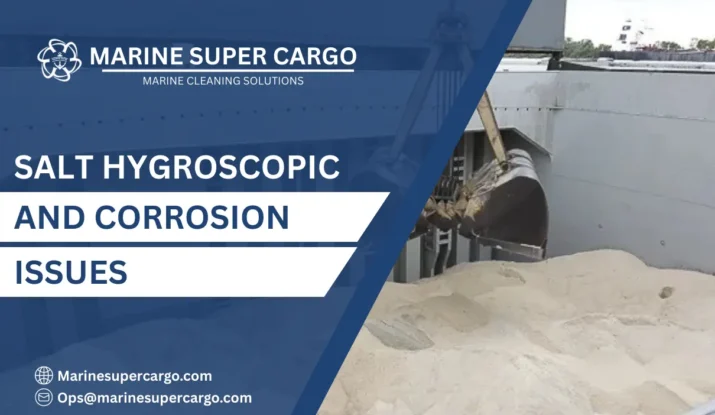Salt hygroscopic and corrosion issues present persistent challenges in bulk carrier operations worldwide. These hygroscopic materials create accelerated corrosion environments that threaten vessel structural integrity and operational safety. Understanding the complex nature of salt hygroscopic and corrosion issues is essential for maintaining vessel longevity and preventing costly structural damage.
The transportation of salt generates moisture-absorbing residues that penetrate deep into cargo hold structures, creating continuous corrosion risks. Salt hygroscopic and corrosion issues demand immediate professional intervention to prevent permanent damage to vessel components. These materials continuously absorb atmospheric moisture, creating persistent wet conditions that accelerate steel deterioration.
Salt hygroscopic and corrosion issues affect all sections of bulk carriers, from bow to stern compartments. The hygroscopic nature of salt creates humid microclimates that support ongoing corrosion processes even after cargo discharge. Port and starboard holds experience varying moisture levels based on atmospheric conditions and ventilation effectiveness during transport operations.
Understanding Salt Contamination Characteristics
Salt hygroscopic and corrosion issues exhibit unique properties that create continuous moisture exposure conditions. Sodium chloride and other salt compounds absorb water vapor from surrounding air, creating perpetually damp environments that accelerate electrochemical corrosion processes on steel surfaces throughout cargo holds.
Salt crystals from salt hygroscopic and corrosion issues penetrate protective coatings and accumulate in structural joints and recesses. These deposits create galvanic cells that promote localized corrosion attack on vessel steelwork. Forward holds near the forecastle often experience more severe contamination due to spray exposure during rough weather conditions.
The crystalline structure of salt allows deep penetration into porous surfaces and coating defects. Salt hygroscopic and corrosion issues create environments where traditional freshwater washing proves inadequate for complete removal. Professional assessment helps identify all contaminated areas requiring specialized treatment protocols.
MARPOL and IMO Structural Protection Framework
The International Maritime Organization (IMO) establishes comprehensive guidelines for managing corrosive cargo residues and structural protection requirements. MARPOL Annex V specifically addresses waste management protocols for salt hygroscopic and corrosion issues cleaning operations.
Salt hygroscopic and corrosion issues cleaning must comply with SOLAS structural integrity requirements for bulk carrier operations. All cleaning procedures must prevent accelerated corrosion that could compromise vessel safety. The IMO mandates regular structural inspections following salt cargo operations to assess corrosion damage.
International regulations require proper neutralization of salt residues to prevent ongoing corrosion processes. Salt hygroscopic and corrosion issues management must align with MARPOL environmental protection requirements while ensuring structural protection and operational safety.

Professional Cleaning Solutions by Marine Super Cargo
Marine Super Cargo specializes in addressing salt hygroscopic and corrosion issues through advanced cleaning methodologies designed specifically for hygroscopic cargo residues. Our experienced teams understand the critical importance of complete salt removal and corrosion prevention protocols.
Our comprehensive approach includes thorough freshwater flushing systems that remove salt deposits from all accessible surfaces. We utilize specialized desalination techniques and corrosion inhibitors designed for salt hygroscopic and corrosion issues remediation. Our teams coordinate systematic cleaning from tank tops to bilge areas, ensuring complete salt neutralization.
Marine Super Cargo employs advanced water treatment systems that remove salt contamination from cleaning wastewater, preventing environmental discharge violations. We maintain strict monitoring protocols throughout all cleaning operations to verify complete salt hygroscopic and corrosion issues resolution and structural protection.
Technical Challenges and Corrosion Prevention Solutions
Bulk carriers face multiple complications when dealing with salt hygroscopic and corrosion issues. Hygroscopic salt deposits create persistent moisture conditions that continue corrosion processes long after cleaning completion. Traditional cleaning methods often fail to remove salt from deep structural penetrations and coating defects.
Port-side and starboard holds often display different moisture retention patterns due to varying ventilation effectiveness and atmospheric exposure. Aft sections near the engine room may experience elevated temperatures that accelerate moisture absorption rates. Forward holds require particular attention to eliminate salt deposits from structural angles and frames.
Professional cleaning services address these challenges through multi-stage desalination protocols. High-pressure freshwater flushing removes surface deposits, followed by specialized chemical treatments that neutralize embedded salt compounds. Final corrosion inhibitor applications provide ongoing protection against salt hygroscopic and corrosion issues.
Prevention and Structural Protection Strategies
Preventing salt hygroscopic and corrosion issues complications begins with proper hold preparation and protective coating maintenance. Ensuring intact coating systems minimizes salt penetration into steel substrates. Regular coating inspections identify defects that require repair before salt cargo operations.
Crew training plays an essential role in managing salt cargoes effectively. Understanding the characteristics of salt hygroscopic and corrosion issues enables prompt intervention when moisture accumulation occurs. Proper ventilation management helps reduce atmospheric humidity levels that accelerate salt moisture absorption.
Marine Super Cargo provides comprehensive protection programs designed to minimize corrosion risks. Our services include coating system maintenance, moisture control protocols, and crew training programs focused on salt cargo handling best practices and salt hygroscopic and corrosion issues prevention.
Industry Standards and Structural Integrity Requirements
Maritime industry standards for handling salt hygroscopic and corrosion issues continue evolving with improved corrosion protection technologies and structural monitoring systems. Modern bulk carriers incorporate enhanced drainage systems and corrosion-resistant coatings. These innovations help reduce structural damage risks and extend coating service life.
Cleaning protocols must balance thorough salt removal with structural protection requirements. Proper freshwater flushing ensures complete desalination while maintaining operational schedules. Salt hygroscopic and corrosion issues management requires coordination between cleaning contractors, coating specialists, and classification societies.
International structural integrity standards demand regular inspection and maintenance following salt cargo operations. Marine Super Cargo facilitates compliance through comprehensive service packages that ensure structural protection and regulatory adherence.
Environmental and Operational Considerations
Modern cleaning approaches for salt hygroscopic and corrosion issues emphasize environmental responsibility and operational efficiency. Closed-loop cleaning systems minimize freshwater consumption while ensuring complete salt removal. Proper wastewater treatment prevents saline discharge that could violate environmental regulations.
Structural monitoring systems detect early corrosion development, enabling prompt intervention before significant damage occurs. These approaches align with MARPOL environmental protection objectives while maintaining vessel structural integrity and operational capability.
Salt hygroscopic and corrosion issues require ongoing monitoring and maintenance programs that extend beyond initial cleaning operations. Regular inspection schedules help identify developing problems before they compromise vessel safety or operational efficiency.
Frequently Asked Questions
Q1: How do hygroscopic properties affect long-term corrosion risk?
A: Salt continuously absorbs atmospheric moisture, creating persistent wet conditions that accelerate corrosion even after initial cleaning, requiring specialized neutralization techniques.
Q2: What cleaning methods effectively remove embedded salt deposits?
A: High-pressure freshwater flushing combined with specialized desalination chemicals and extended soaking periods are necessary to remove deeply embedded salt contamination.
Q3: How long does complete salt neutralization typically require?
A: Complete salt removal varies by contamination severity, typically requiring 48-72 hours including multiple freshwater flushes and chemical neutralization treatments.
Q4: What MARPOL requirements apply to salt cleaning wastewater disposal?
A: Saline cleaning wastewater must be treated to reduce salt concentration before discharge, with proper documentation maintained according to environmental regulations.
Q5: Can salt contamination cause structural certification issues?
A: Yes, persistent salt contamination can lead to accelerated corrosion requiring structural repairs and potentially affecting class certification and operational approvals.
For professional bulk carrier hold cleaning services specializing in hygroscopic cargo residues, contact Marine Super Cargo today. Our expert teams ensure complete salt neutralization while maintaining MARPOL compliance and structural integrity protection.


